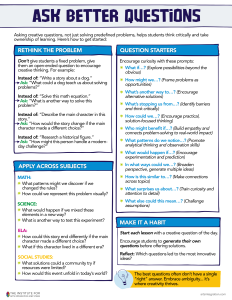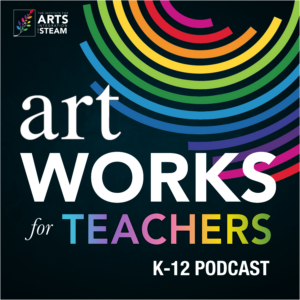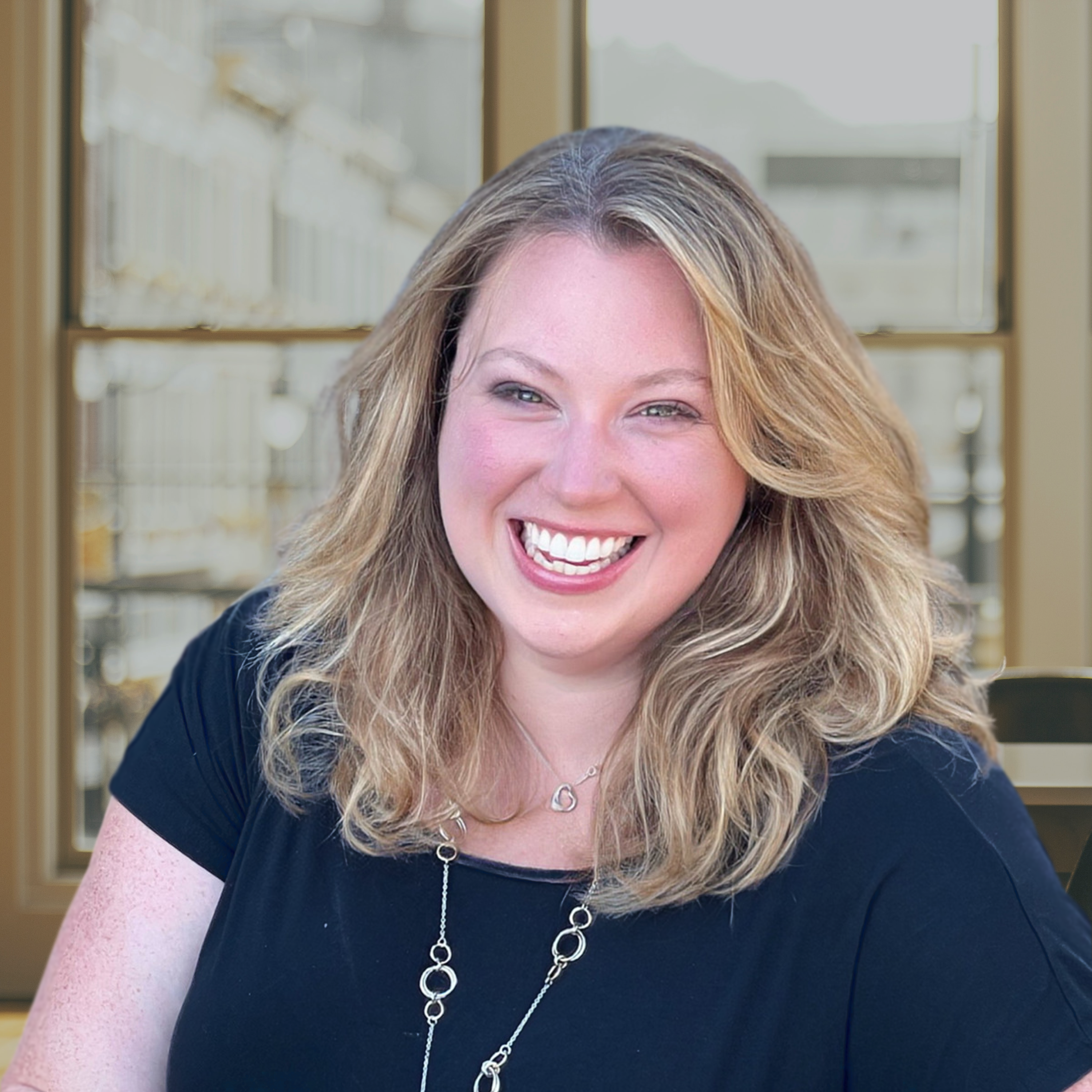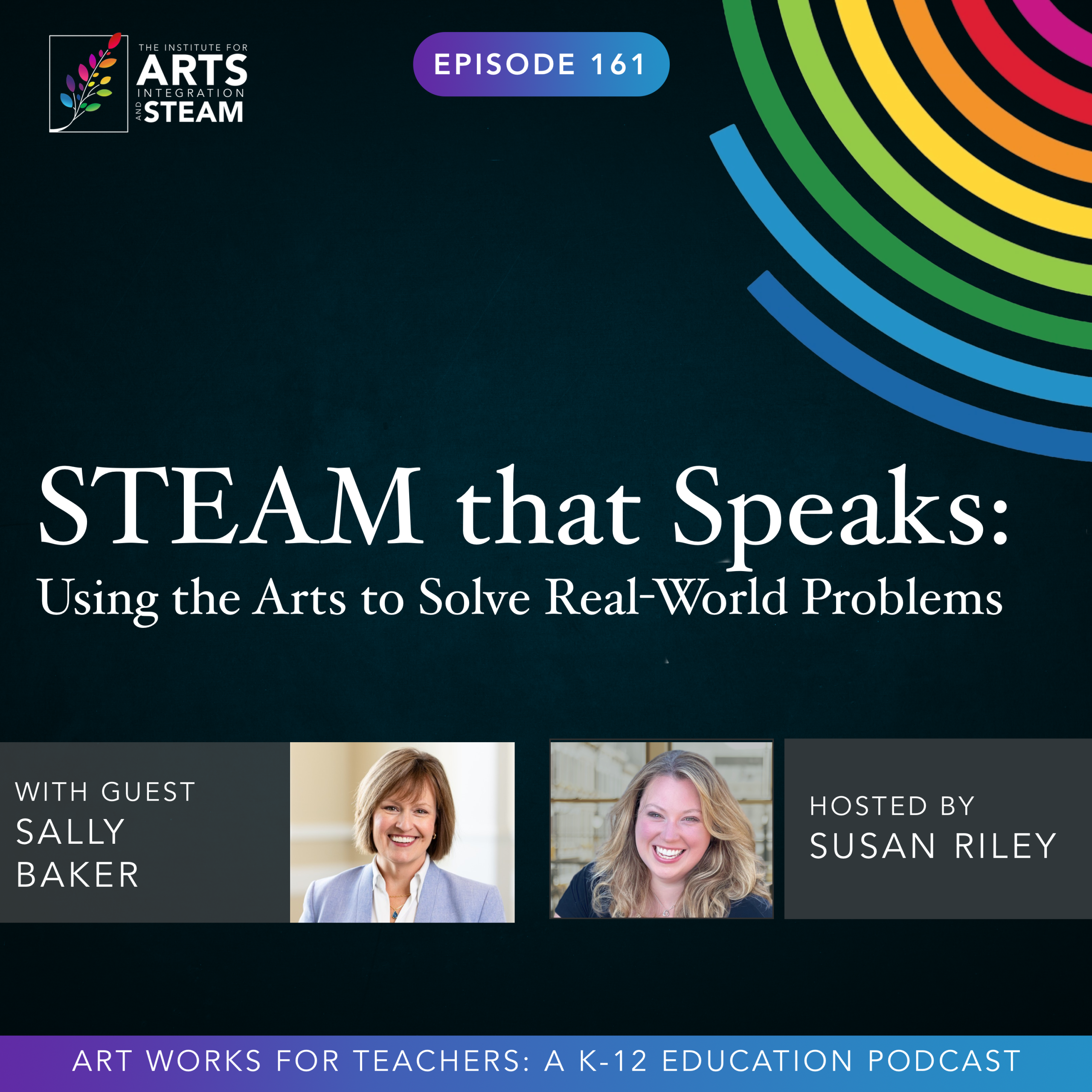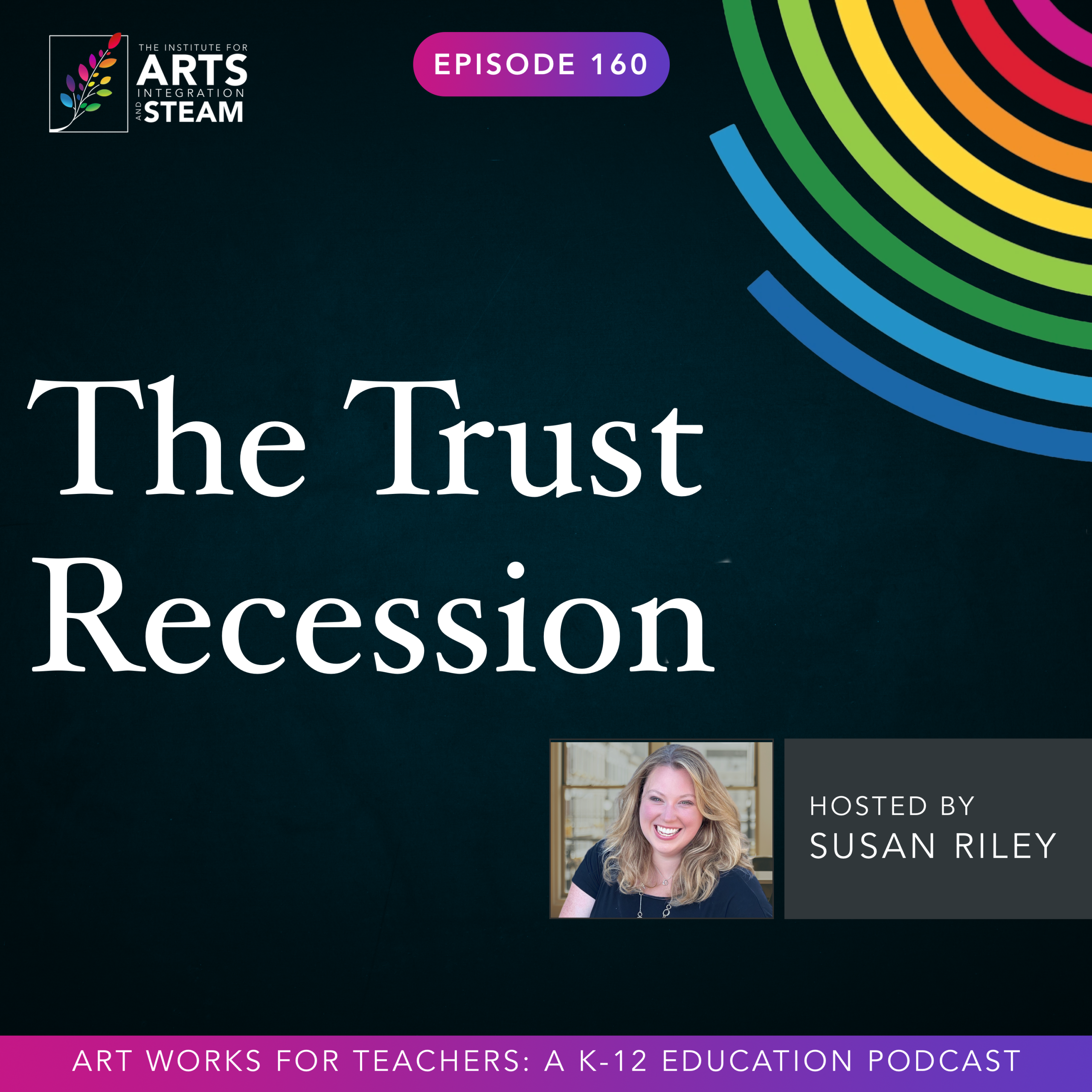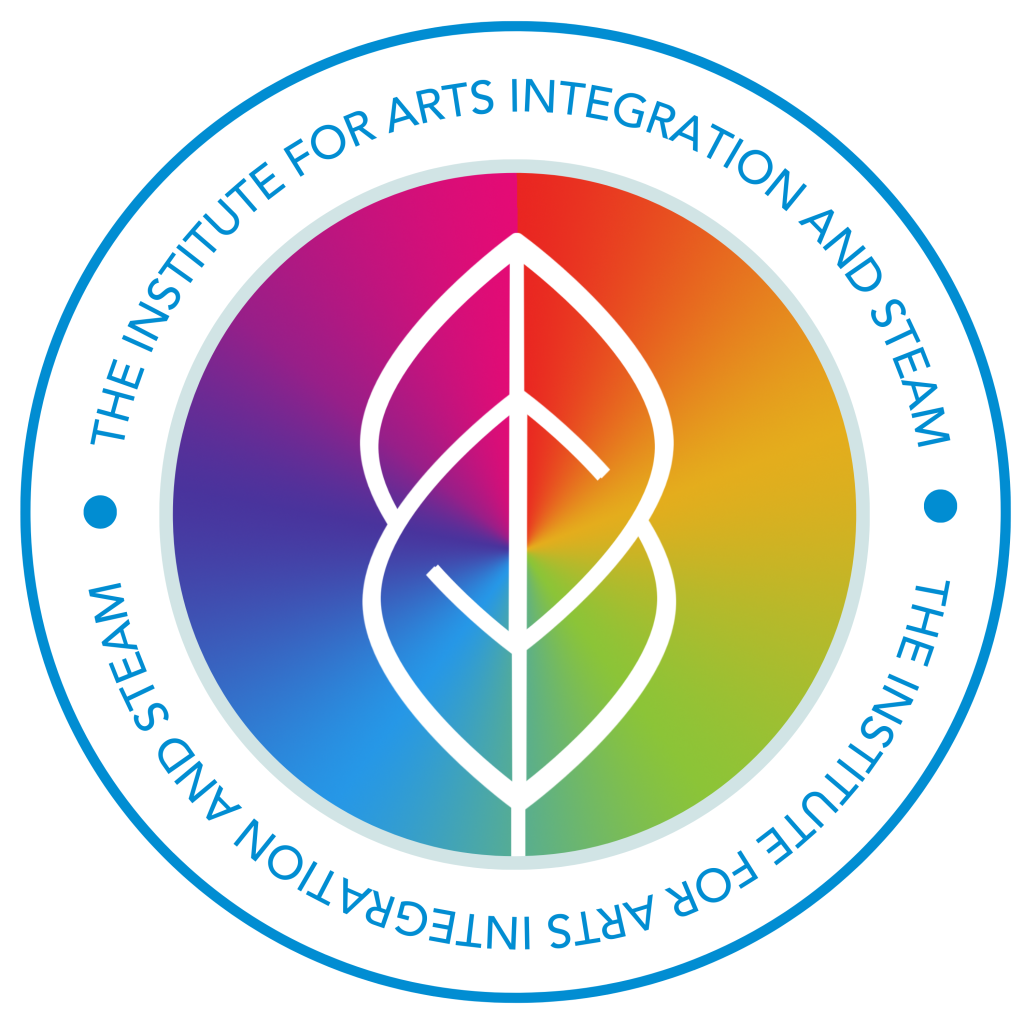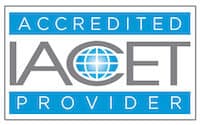ART WORKS FOR TEACHERS PODCAST | EPISODE 150 | 34:21 MIN
The Secret Ingredient to Student Creativity
Enjoy this free download of the Ask Better Questions Resource.
Well, welcome Roger, I'm so glad you're here today.
Roger
It's a pleasure to be here. Thank you, Susan.
Susan
Okay, so let's start with your story. I love starting with stories. I love hearing about the stories of others. And you, my friend, have had a very interesting journey from music to creativity studies and everything in between. Can you share a little bit of your story about how you first fell in love with creativity and gotten this pathway?
Roger
delighted to. I actually grew up on a farm in northern Colorado which is where I'm at right now as I mentioned to you earlier over Christmas I was able to inherit my grandparents house so I'm living part-time in Buffalo where I've lived for 48 years and now back here on the farm and it's a really interesting experience to be back on the farm after 48 years to be living in your grandparents house your ancestors house but this is where I grew up and so as I was growing up
I went to a small rural school and so small school I think there were 81 people in the graduating class and the models for growing up were preacher, teacher or farmer. Now I knew I wasn't going to be a farmer, okay. I wasn't really good at being a preacher I don't think but I think I do that now also and so I was going to become a teacher and I fell in love with guitar. I started playing guitar when I was about 14. My mother made me play piano when I was eight or nine and I couldn't stand it but so glad I stuck with it because when I picked up the guitar at 14. I was playing in rock bands and stuff and so I started to teach guitar and here at local music school studios in Greeley, Colorado then went to the University of Northern Colorado as a music major as a guitarist music major and as I was going through the program I became very frustrated because I'm not the kind of person that can spend a lot of time in an eight by eight practice room by myself and I was also teaching guitar students at about 20 students at the time and that's what essentially got me through college. And I was working with my students, I found they were getting really bored with their initial lessons, their basic lessons, that you have to learn for technique. And so I thought if I could get them to be more creative in how they approach their music, they would enjoy their music more.
So I started reading about creativity and I moved from being a music major into this individualized education program where we can essentially design our own course, meet with a faculty mentor every week. And I had this wonderful faculty mentor who was an anthropologist and a musician and a real Renaissance fellow. And so we began to explore creativity. And I started reading about creativity and I think I kept the bookstore in business in 1976 because I ordered all these special books.
All the books in the bibliographies, I found a theme. And the theme was there was one place and two names that came up consistently in the literature. Those two names were Sydney J. Parnes and Ruth B. Nohler at a place called the Center for Applied, well it was different called then, it was called the Interdisciplinary Center for Creativity Studies at the State University College at Buffalo, New York.
Well, so, so, okay. It's in Buffalo. I'm in Colorado. So I started reading about this and I went to the University of Northern Colorado library and I went to the microfiche. I found the phone number of the department and in April of 1977 I called out there I actually got the Secretary on the phone and she said well, dr. Parnes is here. Would you like to talk to him now? I'm 21 years old at the time and I'm talking to this rock star in the field of creativity They've written all these books Susan what I thought when people gained that eminence is they died, you know, they write books they die so Fortunately, that's not the case having written 7 ok I don't intend to step off anytime soon so I talked with see it on the phone He's wonderful I get so it's so very very excited and I was actually staying at my parents house just across the driveway now on it I was in the basement phone and I ran up the stairs and I said to my mother I said I just talked to Sid parnes in Buffalo, New York. Do you know what she said?
She said, watch, you made a long distance phone call. So phone calls from rural Colorado were pretty expensive back in the seventies. Anyway, in June of that year, I went out to Buffalo, took a conference, took a course, knew what I wanted to do, came back here, finished up my degree and then moved to Buffalo in 1978. I got my master's in 79. I think I was probably like the fourth or seventh person to get the degree. We've now graduated over 800 folks with master of science degrees in creativity and change leadership all over the world. I ran a consulting company for a while. came onto faculty in 1984 as a faculty member and now I'm an associate professor emeritus at the now Center for Applied Imagination in Buffalo. In 1994 I went to a part-time position to run the consulting business and I've worked with about 600 organizations worldwide, both corporate education, all those areas and I still love what I do very very much. So that's the story. and I was talking about, yeah it was quite a story coming from Colorado to Buffalo, quite a change, but my parents were very supportive and you know here he is he's 21 years old he wants to study creativity in Buffalo, what's that? But they've been great so yeah. So that's the story.
Susan
That's a testament. that's wonderful. I mean, what a journey. But still, I'm so glad that it took you here because honestly, one of the things I love about your work is that you make, you have the ability to make creativity practical and repeatable, which is so difficult for a lot of people because we still have this myth hanging out here that, you know, creativity is just for artists and or musicians. But so for listeners who may not know or aren't aware of the work that you do, can you walk us through the basics of the creative problem solving process and why that's so powerful?
Roger
Yeah, and I think that's a really good point. First off, is a myth about creativity that most people don't think they're creative. And we ask people if they're creative, they don't raise their hands. But then I ask the question, have you prepared a meal out of the leftovers in your refrigerator? You know, have you started a business, failed at that business, started again? Have you found a new way to get the kiddos to go to sleep at night? Have you found a new way to tell someone that you love them? That's creativity. So we're all creative. We all create in different valuable ways. Now the thing that's unique about the work that I do is oftentimes the myth about creativity is that you have to sort of leave it to chance. And you you work on a project for a while and then the idea is going to suddenly hit you, know, while you're taking a bath or while you're showering or whatever. Eureka! There's the idea. Well that's fantastic if you've got the time to do that, but in most settings today and is that you don't have the time to come up to wait for those ideas to come. So we work on process of deliberate creativity. And the essence of deliberate creativity are two types of thinking, divergent thinking, where you come up with lots and lots of options, and convergent thinking, where you select those options. There's another type of thinking that comes in that as well, it's called competent thinking. We'll talk about that in a minute. But essentially this process for creativity is a universal process. So whether you're creating an art or a music or in business,
We follow a similar pattern first you identify a goal or a wish or a challenge Like I wish you know I wish I could live in Buffalo and Colorado at same time something like that So and that's all it is. It's just a goal or a wish, it's not a defined problem yet. Then you gather some data about that, get the background. Then you clarify what the problem is. We can talk more about that in a minute. But this is where we figure out what the real problem is, or the best definition of the problem. And the way we do that is we generate lots of creative questions. Creative questions begin with the words, how might I or how to. They're open-ended questions. Then once you diverge out, you select the best of those questions, you generate ideas for solving that. Come up with a whole bunch of ideas, select the best of those ideas then you refine those ideas, make them better, polish out the rough spots, and then you generate all the possible action steps you might need to do, and then you put the plan into action. So first you clarify the problem, you generate ideas, you develop solutions, and then you plan for action. So that's the process, it's universal, this we make it explicit, and there's a variety of methods and techniques to help you to do each stage of that process. That's essentially the creative process.
Susan
Yeah, that's super helpful. I think I'm a person that I like steps. I like knowing what the process is. I like having things that are repeatable. One thing that struck me when I was doing research for this episode was that I found a quote on your site, which was that creativity isn't just coming up with a new idea. It's solving the right problem. I would love for you to dive into that a little bit more because I think that's revolutionary. I think that's something that most people don't consider.
Roger
Thank you and I would love to dive into that. Now let me just push my book here for a minute and it's in my last book called Solve the Real Problem. It's on Amazon or you can get it from my website. We'll talk about that later. Here's what I found. Having been in this business now for about 48 years and worked with thousands of different organizations, one thing that I found in common is that about 99 % of the time what we think is the problem is not the problem at all. It's a symptom of the problem or what the boss thinks is a problem or a knee-jerk reaction to the problem and we do a very very poor job of defining what the real problem is. The reason for that is we have this penchant for action. It's like, hey I don't have time to solve the problem, I gotta get stuff done. I don't have time to figure out what the problem is, I have to do something.
Well, figuring out what the real problem is is doing something. And so the way we figure out what the real problem is is we come up with lots of creative questions. Just as you can generate lots of ideas for solving a problem, you can also generate lots of creative questions to look at a variety of different ways to look at the problem. And creative questions, as I mentioned earlier, begin with a phrase like, how might I? Or how to? Now, for example, there's a big difference between saying, say you're working on a project and you say,
Well, we don't have any money or it's going to cost too much. Those statements block your thinking. They send a message to your brain that there aren't any ideas out there. So why even bother looking for those ideas? But let's try something else. How about I reduce the cost? How about I raise the money for this project? Now all of a sudden those questions send a message to your brain to begin to search for ideas for solving that. And that's essentially what we do in the clarify the problem stage of the process.
And time after time after time again, Susan, I've worked with groups and what they think is the problem is not the problem at all. And it's about 99.9 % of the time whether these are people in industry, in government, in finance, students, teachers, we come in with this predisposition to what we think the problem is and then we move forward with that. And the reason why we've done that is unfortunately as your research has found is that schools have taught us to do this, you know.
We present the problem to you you find the answer to plus two equals four, you know, what's the capital of Poland Warsaw? Okay so, but we don't ask you to come up with what might be all the creative questions that might be involved in adding these numbers together or what might be all the ways to create a capital or something along those lines. We've been giving you the questions already formed and the question making process is really the essence of creativity, really the essence of science because science and discovery begins with questions. It oftentimes ends with answers and questions are oftentimes much more important than answers because they lead to whole new forms of discovery. So that's thing that I found essential. then so the impetus for this book was after I wrote Create in a Flash, I began to do work with medical students. one of the things that they wanted us to work on, the instructor said, we want you to teach these medical students how to ask questions, how to come up with more questions to not only come up with a differential diagnosis, but figure out what, and the whole person, know
just this, you know what is the whole and we talked about that in the book. So that was one inkling of this. The second was I was hired by the Department of Defense to work with strategic command which is in charge of all the cyber security and nuclear security of our country. And then my client said I want you to come out and help our people to figure out how to find problems.
I said, wait just a minute, you guys are in charge of nuclear security and cyber security, what do you need me for? And my client said, well, we live in a command and control environment. What the Admiral says or the Colonel says is the problem, is the problem, but oftentimes it isn't at all. So I did some work with them and then that was the string that started the book. And a book, as you know, kind of starts with a string and it kind of eats at you until you have to write the book. yeah.
Susan
Yes, yes. Well, and I think everybody, you're gonna, we're gonna put in the show notes how you get the book because I think the book answers the how question, like how you create those questions. My follow-up to that is then, how do you know that you've gotten to the right problem?
Roger
A very good philosophical question, alright?
Susan
And my brain is one of those brains that jumps. I I'll fully admit it. jump to the, this must be the problem and I will go fix it. So, and I'm learning the power of the pause as I get older, you know, being able to wait, right? So, but how do you know that you've gotten there?
Roger
Well, let me talk about the power of the pause in a minute. Let's put a pin on that. But let's talk about how do you know what you got there. And the answer is, you don't. You don't know. That's soothing. Okay. But here's the deal. If you came up with one definition of the problem, and then you came up with 30 different definitions of the problem,
And you looked at that whole array of problem statements or creative questions to choose from. There's a 95 % chance that the best problem is somewhere in there and it's always not the first one. the idea, see the problem you see is the problem that you solve. So if you're able to see lots of problems, which aren't necessarily a bad thing, then you can say, hey, you know, that's not it, but this is closer to what everything I know says it is. Okay. So that's miles ahead of saying like, I'm going to grab this one and generate ideas on it. So you can confidently go in to the next stage of the process, idea generation, and say, you know, I've looked at all the possible problems here and this seems to be the best problem to solve at the time. And we had arguments with it, not arguments, but debates around one of my colleagues. I wanted to call it solve the best problem. He said, no, no, no, no, no, people aren't going to get that. He said, you want to solve the real problem because you don't know if it's a real problem until you solve it. But your chances of coming up with a better solution are significant, significantly increased because you've generated a whole bunch of ways to look at the problem from a whole variety of angles. So then you can go in with the assurance that you know based on my best thinking right now, that's what we need to solve as opposed to based on my knee-jerk reaction right now. That's what we need.
Susan
Yeah, yeah, absolutely. Well, and you know, teachers and students and parents, all in education, we're all facing lots of different problems, lots of different challenges, right? So how have you seen that the creative problem solving process has maybe been helpful or made a difference in that arena?
Roger
Boy, I'm so excited about this because a number of things. I work with a lot of teachers and we've had teachers that have come through the program, teachers that have done their degree with our master's degree program go out and they work with students to not to find the problem areas to work on, not to give them an assignment, but you what might be all the problems associated with this? So it opens up their thinking. Now the thing that I'm really excited about right now is I'm doing some work with an organization called ERA, Educational Revolutionist Association. This organization was founded by a teacher who became a very successful entrepreneur, made a lot of money, sold his company, and then wanted to devote his money, his time, to helping students to teach, to give students life skills, like creative problem solving, emotional intelligence, presentation skills, financial skills, interviewing. We're working now with nine to 12th graders. And I just had the opportunity a couple of weeks ago to work with the teachers and the administrators. What they've done is they've taken Create in a Flash, my sixth book, which has a whole learning program it. They've designed 12 lessons around it as far as creativity and they're going to be teaching that to 9th 12th grade students. And a big part of that is problem clarification. And so when you give this to people and they start and they see how well it works, it's like what you said, why haven't I ever been introduced to this before. The thing is that once people begin to see there's options in the way I view this problem, that's extraordinary. And it gives people so much more power so much more control over their life because what they're confronted with, that's not it at all. It could be over here, over here, over here, over here. So we've used it with students in all grades and now this whole initiative that's moving forward right now is really, really, really exciting. And we have 10 pilot schools now. We should be moving on across the country with it. Yeah.
Susan
When we're talking about education, there are so many different layers of problems, right? And so I think educators try to attack problems that are so much bigger than maybe they need to or should be looking at instead of the smaller problems that they can actually attack. How do you advise, like when you're dealing with an industry like education, how do you advise people to select not just the right problem that is the real problem, but the problem that they can actually solve.
Roger
And this is why the idea of selecting the best problem is where we begin with the book. So let's say there's a big overall challenge, a big overall goal or wish. Well, instead of trying to go after that, do some problem redefinition. How to, how might, how to, how might, how to, how might. We just did this with administrators a couple of weeks ago on this. And it was a goal or wish. would be great if we could, the goal was it would be great if we could make more connections with our students and potential employees.
Okay, employers, okay, that they could then interview and work with. Well, that's a great goal, but it's not a statement of the problem. And so if you're to try to generate ideas against that, they would be abstract and they wouldn't have any traction. And so what we did was we said, okay, that's the goal.
What do we know about it? Got a little bit of data out and then we generated a whole bunch of creative questions. And then we were able to break those creative questions down into various avenues or tributaries if you would that would solve this big problem. So we'll go after this one and solve it after this one and solve it and all of a sudden this big problem becomes much less of a problem because you've dealt with all the factors contributing to it. And nine times out of ten, know, people are going to say that wasn't the problem at all. was this, it was this, it was this. And oftentimes there's a number of sub-problems that come out with that. Well, that's great. So you hit them one at a time. Okay, so here's the problem here. Let's generate some ideas for this. Solve this one. Here's the other one. But they're identified out in front of you, you can see them, they're on a flip chart, they're listed there, you can check them off as you solve them, and there's great satisfaction in doing that. So that's what I work, and that's what recommends really practical, yeah.
Susan
It's like eating an elephant one step at a time, just like one bite at a time. Yeah, now, Roger, a lot of the CPS process sounds similar to design thinking or the IDEO process, but you've pointed out that these two things are not exactly the same. So tell me, help me unpack the difference on the two types or processes.
Roger
Yeah, yeah. First, just want to go on record to say that design thinking did a lot of borrowing from creative problem solving without a lot of attribution. yeah. And so, so there was, if you look at design thinking, creative problem solving is all a part of that, but there's not any attribution giving back to that. So that aside, the difference is design thinking is design thinking it's designed to do products. It's decided to do things along those lines So it's great if you want to design a computer mouse. It's great if you want to design a new shopping cart You know, it's great if you want to design tangible stuff like that But as far as the more open-ended as far as the more more more Diffuse challenges it doesn't work well on that because it needs to come in with something. That's a bit more well defined creative problem solving says, hey, it would be great if we could do this. I don't have any idea how to approach this. It scares me, I don't know. And so that whole process of clarifying what the problem is is so crucial. And then the other thing too is really generating lots and lots of ideas for solving the problem and then picking the best one. So going for the quantity in coming up with creative questions.
And also the quantity and generating ideas. but that's where, that's where creative problem solving, creative problem solving subsumes lots of other processes. It's eclectic. It's big enough to, to, to subsume those. And then from that, you can pull out things like design thinking, you know, like synetics, like other, like, like other thinking tools, but the whole granddaddy of them all, the whole general system really is the whole creative problem solving process. So that's the main differentiator. And that's why it's so appealing to teachers and stuff, because it's like,
We can use this with our students on something that's not an invention. So, yeah
Susan
Yes, well, and I think too, there's been such a… for a long time, there was a real focus on the development of things, right? And I think one of the maybe positives of AI that maybe we're not really thinking about yet is that the thing is no longer the thing. It's all of the other contributing factors, the things that are gonna be more meaningful maybe long-term than something that is disposable. And that's where I find this process really valuable.
I have to ask, there's a, you have a snippet on your site that says that you helped Clorox solve a 77 year old problem in 15 minutes. And I think you want to talk about value when people are like, well, design is all about value. no, I think solving something that's been a thorn in your side for almost a century in 15 minutes is something valuable. So I would love to hear about that. You don't have to talk about the problem, but I would love to hear the process.
Roger
Boy, you know this is proprietary. Yeah, so so let me just just say this there was so what they did was there's a certain product that Clorox had acquired and when you use this product the what generally happens is you keep the product wet and and so But the product was decomposing when it was kept wet.
So there was always the instructions, always the instructions, keep it wet, keep it wet. And so the biggest complaint from customers is that the product would break down. Well, one day an engineer said, well, let's flip this around. What if we kept it dry?
So by keeping this product dry essentially they developed a solution that kept the product dry and it's it's say it's it's totally switched the product around totally made a significant difference, but it was just that change of view and Oftentimes just that simple. Well, what if we kept it?
Dry wet instead of dry and and the breakthrough that came in in 15 minutes the whole idea of saving general motors You know, uh, what was it? $50,000 a week on how they produced the ring gears that go in cars Was coming up with an idea from the there is a problem with the ring gears were sticking in the die One of the folks that works on them is well Why don't you spray them with a vegetable product pay them that led to the idea of? Of a solution that they would spray on the die that would allow the metal not to stick now that, that's another type of thinking, and we can just talk about that. So we talked about divergent thinking, we talked about convergent thinking. There's another type of thinking that's called combinent thinking. And combinent thinking is borrowing ideas from different disciplines, different areas. So we're working on a mechanical problem here, and this person came up with an idea from the cooking area and blended that in together. That's combinent thinking, combining things in a different way.
And that's the real essence of it.
Susan
Wow. Yeah, and that's we promote with Arts Integration and STEAM all the time, is being able to connect to areas that maybe wouldn't normally be connected in a natural way, right? So I'm a big fan of that kind of thinking, but it takes a bit. You've got to be able to practice, I think, you've got to be able to practice all of them and have skills and tools, right?
Roger
It's beautiful when you say about practice and one of the things that we do also when we're working with groups is we always do a warm-up exercise before we work on the real problem and So we work on something like really silly, you saying we're gonna really really serious problem Well, if you to go in and try and solve that problem with that mindset you would go nowhere All right, so we work on problems like you know how to get it how to get a hippopotamus out of a bathtub You know, know how to get an elephant out of a refrigerator, you know, you know fun goof what to do with 10 million ping pong balls, know, what to do with 10,000 boom boxes that they have. So fun, stuff like that. And people loosen up with that and they have fun. And then you take that energy and the learning that they have from that and then apply it to the real challenge. And I'll often ask groups, I'll say, well, what would have happened if we would worked on the tough problem first instead of the warmup? And it's unanimous they'd say it wouldn't have worked. It would have failed.
So with that in mind, is that what you would advise teachers who might have like limited time or might be feeling stretched thin? Would you advise them maybe to start with something simple or silly before you actually put this into your classroom as a full of fledged, you know, process?
Roger
absolutely all the time, unequivocally. And so that's what I can say for sure, all right? Because in my career when I neglected to do that, I neglected to do that twice. That was early on, I had to go back and do a warmup, all right? It's that important. And in this work that we're doing with Education Revolution Association, we build in the warm-ups into the learning activities. Now here's the deal about a warm-up. It's only five minutes. and it's important that people understand the purpose of a warm-up. It's a training session, okay? And when I work with my military folks, they say we're going to train first before we go on the mission. When I work with my performing folks, it's like we're going to practice first before we perform, all right? It sanctions the time for speculation. It teaches them the techniques, and it creates a judgment freeze.
So you want to create a judgment free zone when you want to generate those ideas and then you also need to give them some techniques. So that's when you teach them the guidelines for brainstorming, defer judgments, strive for quantity, seek wild unusual ideas and combine and build other ideas. And so work on something fun, work on something silly, play around with the connection making process on that and then work on the tough problem.
Susan
Well, Roger, I could talk to you all day, but unfortunately we're like running out of time. Yeah, yeah. So before we go though, where can our listeners go to learn more from you, to connect with you, and to dig deeper into your books and resources?
Roger
Yeah, just go to my website rogerfirestein.com and I'll just show it spelled F-I-R-E-S-T-I-E-N. There's the books that are on there. There's a nine part series on innovation that we've done through the Open Sesame eLearning platform that's this high production quality. We're using that with a number of organizations with this educational organization as well. There's also an entire online course that's based on this book on how to facilitate creative problem solving. Lots of free resources, lots of free blogs, videos, and stuff and my Innovation Espresso newsletter that you can sign up for. It's free and it comes out just about every month and don't worry it's all written by a person not AI. I write and we write them for fun. So we write articles about hanging around on a farm and doorknobs.
Susan
Well, I love it and we will put all of those links into our show notes for today. Roger, thank you so much for your time.
Roger
Thank you, Susan. My pleasure.
Sign up for the Innovation Espresso newsletter

